Violet "AV-Panakota": description of the variety and cultivation features

Violets are a spectacular decoration for window sills and balconies of many plant lovers. Florists love this culture for its beautiful and lush flowering. The violet "AV-Panakota" is of particular admiration. You can admire for hours the large double petals in pink and white with a greenish frill.
Breeding history
This is an amazing flower with a hundred-year history of development and selection. For the first time in Africa in the mountains of Tanzania, near the settlement of Uzambar, a beautiful, previously unknown plant was discovered by Saint-Paul Iller. He collected the seeds and sent them to Germany, where his father Walter gave the planting material to the botanist Hermann Wendland. This is how a new variety with the name Saintpaulia Uzambarskaya appeared.
In appearance, Saintpaulia looks like a violet. However, they actually differ in genus in the classification. Nevertheless, even today, many continue to call senolia just a violet. Breeders are constantly breeding species of this culture, incredible in beauty and diversity. So the Moscow breeder Alexei Pavlovich Tarasov brought out a unique series of AB violets. This group also includes "AV-Panakota", the description of which we will consider below.

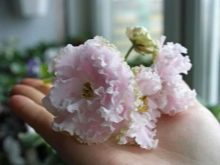
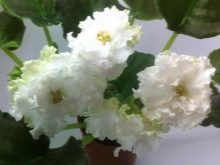
Features
Variety of violets "AV-Panakota" appeared in 1913. He immediately gained popularity among plant breeders for its unusual flowers. Reminiscent of whipped cream, delicate wavy petals are successfully combined with a rosette of rich green leaves.
It is a perennial evergreen with a shortened stem. Leaves are cordate, slightly elongated, with a wavy edge and a sandy skin covered with villi. They form a lush rosette at the roots. The inflorescences consist of five large petals (up to 8 cm in diameter) with two stamens in the middle. The flowers are white with a creamy pink tint. Greenish "ruffles" are often formed along the edges. The fruits look like small seed pods.
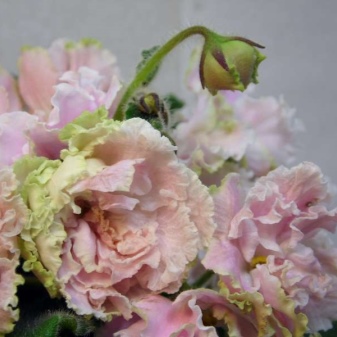
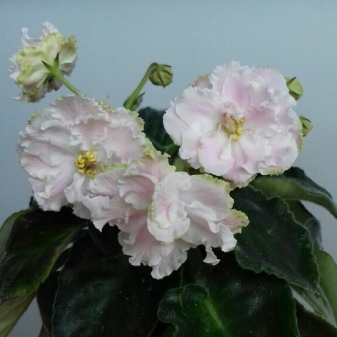
Care rules
It is important to correctly determine the place for a suitable placement of the Saintpaulia of this variety, organize timely watering and maintain the temperature regime. Window sills on the southeast and east sides are suitable for placing violets. Plants are provided with 12-hour lighting, additional fluorescent lamps are provided, since a lack of light leads to poor flowering. In summer, the sun's rays, falling on the leaves, can burn them, so a protective scattering screen is placed in front of the plant.
The temperature is maintained within the range from + 20 ° C to + 25 ° C. A sharp drop in degrees slows down the growth of the plant and leads to death. With regular ventilation of the room, drafts are not allowed. To control air humidity (it should be in the range of 50-60%), a hydrometer is purchased. In a dry atmosphere, the crown withers, the flowers fall. They also control soil moisture. Water the flowers only with room temperature water that has been separated for at least two days. In the summer, watering into the pallet is carried out 2 times a week, avoiding stagnation. Root watering from a watering can under the stem is also used without soil erosion. In winter, watered once a month. A lattice is placed under the pot, the roots of the plant are protected from freezing. Once a month, to cleanse the flower of dust, arrange a shower by spraying from a spray bottle. Then the leaves are dried so that spots do not appear on them.



Saintpaulias love to grow in cramped conditions, the pot is chosen in the size of 6 by 10 cm. For planting, a special soil balanced in composition is used, which, together with drainage, is purchased from a gardening store. The best are plastic pots, new and free of salt deposits. Saintpaulias are transplanted without replacement once every three years, which ensures constant flowering.
Cut the rosette regularly, leave three rows and remove dry wilted leaves. Pruning is carried out only with a disinfected, sharp knife. The cut is covered with activated carbon powder, so the plant is protected from the appearance of diseases. For feeding, special violet complex fertilizers are chosen. They are available in the form of liquids, sticks, powders for dissolving in water. They are used only in autumn and spring.
Before adding nutrient mixtures, the soil is moistened so as not to burn the plant roots.


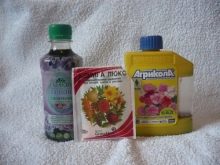
The nuances of growing
Sometimes when growing Saintpaulia, you will notice that with a relatively healthy appearance, there is no flowering. In this case, you should take a closer look at the flower. If the foliage stretches upward or has become faded, then this is a signal that the plant does not have enough light. With an excess of fertilizers with potassium, the leaves turn yellow, with nitrogen - they grow excessively. Folk feeding in the form of shells, peels from bananas, tea leaves are not recommended, midges appear from them and diseases spread.
For violets, it is dangerous to be close to hot radiators in winter, when they have a rest from flowering. If the saintpaulia wilted when the room temperature drops, it is transferred to a warm place, then it comes to life. An unbalanced soil composition, too large a pots, or a plant in one place for more than three years can also lead to the fact that flowering does not appear. Do not allow both drying and waterlogging of the soil. Activated carbon is added to hard water for softening.
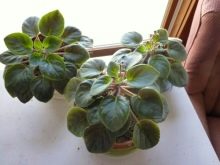


Transplant and reproduction
The transplant is carried out during a period when there is no flowering. The plant is removed from the impregnated soil, the rotten roots are cut off. The plant is transferred to a prepared pot with drainage, soil is poured, not reaching the edge of a centimeter. The earth is spilled with water with potassium permanganate or antimicrobial compounds to prevent diseases. The most common and affordable way of propagation is by leaf or cuttings. A healthy, undamaged leaf with a long handle (up to 4 cm) is selected and cut off with a sharp knife. Place it in a container with warm water softened with an activated carbon tablet. After the appearance of roots about 1 cm, the shoot is planted in deactivated soil and a greenhouse is built from a transparent bag or box.
With the growth of the bush, the rudiments of new rosettes are formed, which interfere with the development of the plant. The newly appearing process is carefully separated from the mother bush and placed in the water until the roots appear. Then it is transplanted into the ground, also creating greenhouse conditions.
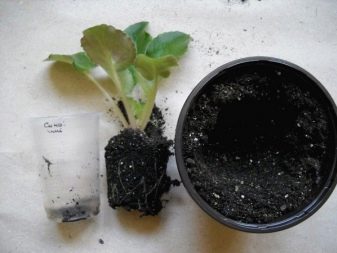

Disease and pest control
Violets "AV-Panakota" are susceptible to infection with pathogenic microbes and attacks of parasites with improper care (due to waterlogging of the soil, cold to the roots of the windowsill or frequent drafts).
- When, due to powdery mildew, the plant is covered with a bloom, the bush is treated with a fungicide solution.
- With gray rot, which spreads along the crown, the fluffy bloom is removed, the plant is also treated with fungicides.
- When the roots decay caused by fusarium, the leaves turn gray and fall off. For treatment, drugs such as Fundazol and Benomil are used.
- The appearance of red spots with cobwebs on the leaves indicates the presence of a spider mite. It is well removed by treating the plant with an insecticide.
- If aphids cover the plant, spraying the flower with Mospilan solution will help get rid of it.
- The appearance of small worms on the roots indicates the presence of dangerous rootworm nematodes. In this case, the plant is discarded.


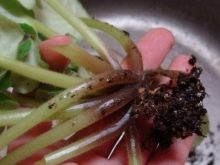
Reviews
In positive reviews, amateur flower growers talk about the AV-Panakota violet variety with delight. They note the breeding characteristics of the AB series, the unusual color of the inflorescences, recall the Italian dessert made of whipped cream "Panna Cotta" associated with the name of this beautiful plant. Among the shortcomings, it is noted that the variety is capricious, unadapted to changes in environmental conditions.
The flower needs constant care and attention. Otherwise, it withers and dries up.
In the next video you will see the first flowering of the young AV-Panakota rosette.































The comment was sent successfully.